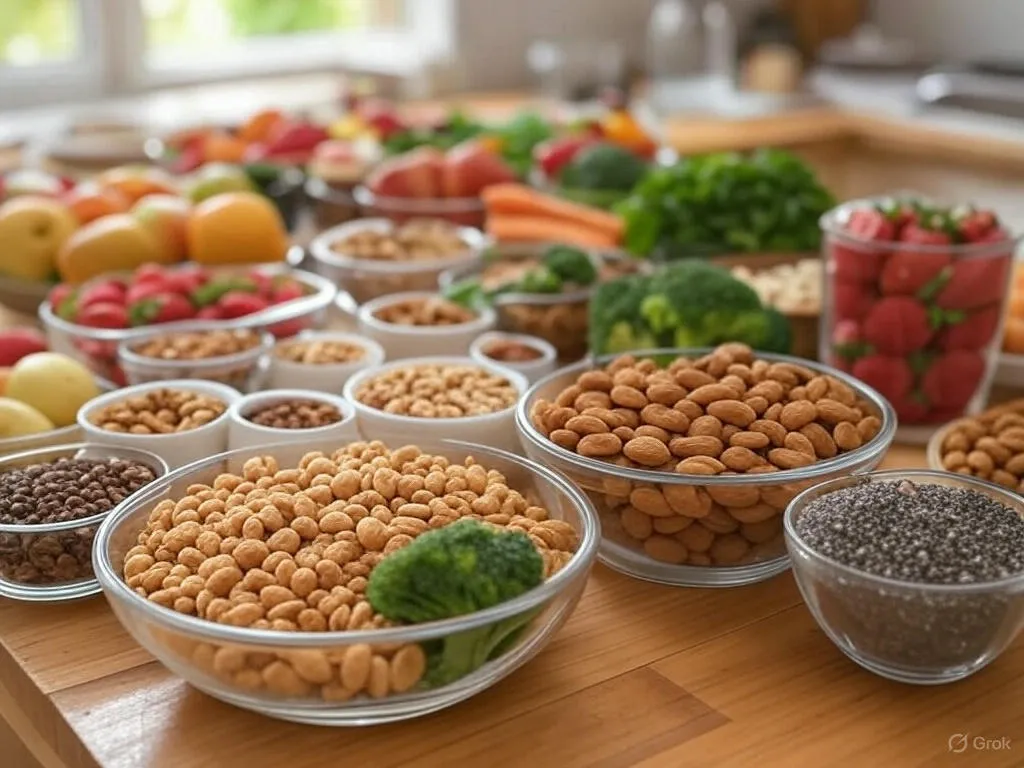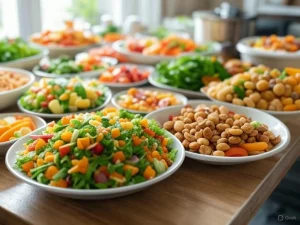
Can Certain Foods Help With Weight Loss?
Losing weight is not just about eating less—it’s about eating smarter. The NHS promotes a balanced diet rich in nutrient-dense, high-fibre, and protein-packed foods to help regulate appetite, boost metabolism, and reduce overall calorie intake.
✔ Eating whole, unprocessed foods can keep you full for longer.
✔ Protein and fibre-rich meals support metabolism and digestion.
✔ Hydration and portion control play a key role in weight management.
📌 Check Your BMI to Set Your Weight Loss Goals
What Makes a Food Ideal for Weight Loss?
Weight loss-friendly foods share common traits that help regulate hunger, improve metabolism, and reduce overall calorie consumption.
✔ High in fibre – Keeps you full and aids digestion.
✔ Rich in protein – Supports muscle retention and satiety.
✔ Low in calories – Helps create a calorie deficit without deprivation.
✔ Nutrient-dense – Provides essential vitamins and minerals.
✔ Slow-digesting carbohydrates – Prevents blood sugar spikes and cravings.
📌 Find NHS-Recommended Meal Plans Here
Top 10 NHS-Approved Weight Loss Foods
1. Oats – A High-Fibre Breakfast Choice
Oats are an excellent source of soluble fibre, which helps slow digestion and keeps you full for longer.
✔ Low in calories but rich in complex carbohydrates.
✔ Helps stabilise blood sugar levels, reducing cravings.
✔ Boosts gut health with prebiotic properties.
Best way to eat: Porridge with berries and nuts for added nutrients.
🔗 Best Low-Calorie Meal Plans for Weight Loss
2. Leafy Greens – Low in Calories, High in Nutrients
Spinach, kale, and lettuce are packed with vitamins, minerals, and fibre while being extremely low in calories.
✔ High water content aids hydration and digestion.
✔ Loaded with antioxidants that support metabolic function.
✔ A great alternative to high-calorie side dishes.
Best way to eat: Add to salads, soups, or smoothies.
🔗 NHS-Approved Exercises for a Healthy BMI
3. Eggs – A Protein-Packed Superfood
Eggs are one of the best sources of high-quality protein, keeping you full and reducing overall calorie intake.
✔ Supports muscle retention and metabolism.
✔ Rich in healthy fats and essential vitamins.
✔ Promotes satiety, reducing the urge to snack.
Best way to eat: Boiled, scrambled, or in an omelette with vegetables.
4. Lean Protein – Keeps You Fuller for Longer
Chicken, turkey, tofu, and fish provide high-quality protein essential for weight loss.
✔ Boosts metabolism and helps build lean muscle.
✔ Reduces appetite by increasing satiety.
✔ Lower in fat compared to red meat.
Best way to eat: Grilled, baked, or stir-fried with vegetables.
🔗 Check Your Waist-to-Hip Ratio for a More Accurate Measure
5. Greek Yoghurt – A Gut-Healthy Snack
Greek yoghurt is rich in probiotics, calcium, and protein, making it an ideal snack for weight loss.
✔ Improves gut health, aiding digestion and reducing bloating.
✔ Higher protein content than regular yoghurt.
✔ Low in sugar when unsweetened.
Best way to eat: With berries and nuts as a breakfast or snack.
6. Lentils & Beans – A Plant-Based Protein Source
Lentils, chickpeas, and black beans are high in protein and fibre, promoting weight loss while providing essential nutrients.
✔ Keeps you full without excessive calories.
✔ Regulates blood sugar levels.
✔ A cost-effective and versatile protein source.
Best way to eat: In soups, salads, or curries.
7. Berries – Low in Sugar, High in Antioxidants
Strawberries, blueberries, and raspberries are naturally low in sugar and packed with antioxidants and fibre.
✔ Satisfies sweet cravings without excess sugar.
✔ Boosts metabolism and supports digestion.
✔ Rich in vitamin C and essential nutrients.
Best way to eat: With porridge, Greek yoghurt, or smoothies.
8. Avocados – Healthy Fats for Weight Management
Avocados contain heart-healthy monounsaturated fats, which help control appetite and support overall health.
✔ Keeps you full longer by reducing hunger hormones.
✔ Provides essential fatty acids and vitamins.
✔ Supports healthy digestion and nutrient absorption.
Best way to eat: Sliced on whole-grain toast or in salads.
🔗 How to Reduce BMI Safely & Effectively
9. Nuts & Seeds – Nutrient-Dense Snack Options
Almonds, walnuts, chia seeds, and flaxseeds provide a great balance of healthy fats, protein, and fibre.
✔ Helps maintain steady energy levels.
✔ Supports weight loss by reducing hunger between meals.
✔ Packed with omega-3 fatty acids and antioxidants.
Best way to eat: As a snack or sprinkled over yoghurt and salads.
10. Green Tea – A Natural Metabolism Booster
Green tea contains catechins and caffeine, which can enhance fat-burning and metabolism.
✔ Increases energy expenditure.
✔ Supports digestion and hydration.
✔ A healthy alternative to sugary drinks.
Best way to drink: Hot or cold with lemon for added flavour.
📌 Use the NHS BMI Calculator to Track Your Progress
Frequently Asked Questions (FAQs)
What are the best NHS-approved foods for weight loss?
✔ High-fibre, protein-rich foods like oats, lean meats, beans, and leafy greens.
Can eating more protein help with weight loss?
✔ Yes, protein increases satiety and boosts metabolism, making it a key factor in weight management.
Are all low-calorie foods good for weight loss?
✔ Not necessarily. Focus on nutrient-dense foods rather than just low-calorie options.
📌 Check Your BMI & Start Your Healthy Eating Plan
Key Takeaways
✔ NHS-approved weight loss foods are high in fibre, protein, and healthy fats.
✔ Balanced meals with whole foods support metabolism and satiety.
✔ Portion control and hydration play key roles in effective weight management.
📌 Start Your Weight Loss Journey with the Right Foods
Related Guides & Resources
✔ What is BMI?
✔ NHS BMI Chart
✔ Waist-to-Hip Ratio Calculator
✔ NHS Weight Loss Plan




